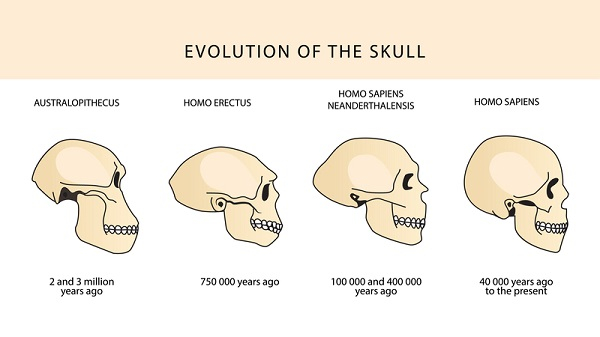

Anatomy is the branch of biology that deals with the internal structures of animals or plants. This study helps us to gain insight into the internal systems of an organism, its adaptive features, its ancestors, etc. Comparative anatomy of Man and Apes performs the same function, wherein various internal parts of man and apes are compared to find out the evolutionary processes, the point of divergence, similarities, main ancestors, etc. Man and Apes, even though they belong to the category of primates, are two different species. This difference is due to their genetic makeup, which led to their evolution and separation from each other.

Apes belong to the Hominoidea family and are the closest relatives of Humans. Apes are differentiated into two groups i.e, greater apes and lesser apes. The greater apes include gorillas, orangutans, bonobos, and chimpanzees; the lesser apes include gibbons and siamangs. Apes generally reside in jungles, mountains, tropical and monsoon rainforests, etc. Most apes are herbivores and they eat fruits, leaves, flowers, etc, but occasionally they eat insects to meet their nutritional requirement. Apes are considered to be the most social animals and they always live in groups to eat, play and protect each other.
To better understand Humans and Apes their anatomical structures are compared. This information helps us to understand the relatedness of these organisms and also shows various differences which make humans more evolved as compared to apes.
| Human | Ape |
|---|---|
| Skull | |
| Skull is highly developed in the frontal region, the forehead extends vertically upward. | Skull is less developed and the forehead slides backward. |
| The sagittal crest is absent in the skull. | A sagittal crest is seen in the skull. |
| Foramen Magnum is present in the centre of the skull. | Foramen Magnum is present backward at the base of the skull. |
| Human head remains upright straight and is properly balanced. | The ape head is generally hanging downwards, thus not properly balanced. |
| Supra-orbital ridge not developed. | Supra-orbital ridge well-developed. |
| Mandible | |
| Lower jaws are smaller. | Lower jaws are huge. |
| Well developed chin is seen. | Chin is absent. |
| Muscles that aid in the movement of the jaws are weak. | Muscles that aid in the movement of the jaws are strong. |
| Generally, the upper or lower jaw is not protruding. | Protrusion of the upper and lower jaws is common. |
| Teeth | |
| Smaller in size. | Larger in size. |
| The dental arch is parabola shaped. | The dental arch is U-shaped. |
| Canines remain at the level of all other teeth. | Canines protrude beyond the level of all other teeth. |
| Canines protrude beyond the level of all other teeth. | Chewing can be done in one direction- up and down. |
| Nose | |
| Root and the bridge of the nose are slightly raised. | The root and bridge of the nose are not raised. |
| The tip of the nose has a thick bulb-like structure. | No nose tip is seen. |
| Cartilaginous portion is narrow. | Cartilaginous portion is wide. |
| Legs | |
| Femur is long, slender, and elongated. | Femur is short, thick, and curved. |
| Ridges for muscle growth are well-developed. | Ridges for muscle growth are not well-developed. |
| Gives erect posture to the human body | Gives curved posture to the ape body |
| Responsible for bipedal locomotion. | Responsible for quadrupedal locomotion. |
| Foot | |
| Foot is used for locomotion and balancing the body. | Foot is used for locomotion and grasping tree branches. |
| Toe is not opposable | Toe is opposable |
| Lateral toes are small. | Lateral toes are comparatively big. |
| Lips | |
| Upper lip shows a median furrow that begins from the nasal septum and continues toward the edge of the lip. | The lips do not show any median furrow and are loose and protrusive. |
Humans share about 98% of their genetic material with some of the greater apes. Apes are generally misunderstood as monkeys, but that is incorrect. Monkeys and apes, even though they appear monkey-type, have various physical and internal differences. Comparative study of various characteristics between species gives us information regarding their special features that separate them into two individual species and make them unique. Some of the special features of humans are- brain size, bipedalism, opposing thumb, etc. Some special features of apes are- Quadrupedalism, opposing toes, and thumbs, dental arch, etc.
Q1. Give the classification of a Gorilla.
Ans. Gorillas are classified as follows
Q2. Give similarities between humans and apes.
Ans. Following are similarities in apes and humans
The blood type system is the same.
Both lack external tails
Same arrangement of various internal organs
Q3. How is the brain of apes and humans?
Ans. The human brain is large and highly potent. The average cranial capacity of humans is 1300-1450 cc. It is strongly affected by external influences and has the ability to perform various complex functions. Amongst apes, Chimpanzees are the most intelligent, they have the ability to work with tools, can communicate, and are problem-solvers. Their average cranial capacity is 400cc.